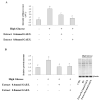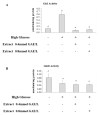Protection of Polyphenols against Glyco-Oxidative Stress: Involvement of Glyoxalase Pathway
- PMID: 33081239
- PMCID: PMC7602851
- DOI: 10.3390/antiox9101006
Protection of Polyphenols against Glyco-Oxidative Stress: Involvement of Glyoxalase Pathway
Abstract
Chronic high glucose (HG) exposure increases methylglyoxal (MGO)-derived advanced glycation end-products (AGEs) and is involved in the onset of pathological conditions, such as diabetes, atherosclerosis and chronic-degenerative diseases. Under physiologic conditions the harmful effects of MGO are contrasted by glyoxalase system that is implicated in the detoxification of Reactive Carbonyl Species (RCS) and maintain the homeostasis of the redox environment of the cell. Polyphenols are the most abundant antioxidants in the diet and present various health benefits. Aims of the study were to investigate the effects of HG-chronic exposure on glyco-oxidation and glyoxalase system in intestinal cells, using CaCo-2 cells. Moreover, we studied the effect of apple polyphenols on glyco-oxidative stress. Our data demonstrated that HG-treatment triggers glyco-oxidation stress with a significant increase in intracellular Reactive Oxygen Species (ROS), lipid peroxidation, AGEs, and increase of Glyoxalase I (GlxI) activity. On the contrary, Glyoxalase II (GlxII) activity was lower in HG-treated cells. We demonstrate that apple polyphenols exert a protective effect against oxidative stress and dicarbonyl stress. The increase of total antioxidant capacity and glutathione (GSH) levels in HG-treated cells in the presence of apple polyphenols was associated with a decrease of GlxI activity.
Keywords: AGEs (advanced glycation end-products); glutathione; glyoxalase system; hyperglycemia; methylglyoxal.
Conflict of interest statement
The authors declare no conflict of interest.
Figures




Similar articles
-
Interplay among Oxidative Stress, Methylglyoxal Pathway and S-Glutathionylation.Antioxidants (Basel). 2020 Dec 28;10(1):19. doi: 10.3390/antiox10010019. Antioxidants (Basel). 2020. PMID: 33379155 Free PMC article. Review.
-
Protective effects of ferulic acid and related polyphenols against glyoxal- or methylglyoxal-induced cytotoxicity and oxidative stress in isolated rat hepatocytes.Chem Biol Interact. 2015 Jun 5;234:96-104. doi: 10.1016/j.cbi.2014.11.007. Epub 2014 Nov 18. Chem Biol Interact. 2015. PMID: 25446858
-
The Role of Oxidative Stress in Diabetic Neuropathy: Generation of Free Radical Species in the Glycation Reaction and Gene Polymorphisms Encoding Antioxidant Enzymes to Genetic Susceptibility to Diabetic Neuropathy in Population of Type I Diabetic Patients.Cell Biochem Biophys. 2015 Apr;71(3):1425-43. doi: 10.1007/s12013-014-0365-y. Cell Biochem Biophys. 2015. PMID: 25427889
-
Effect of High Glucose-Induced Oxidative Stress on Paraoxonase 2 Expression and Activity in Caco-2 Cells.Cells. 2019 Dec 11;8(12):1616. doi: 10.3390/cells8121616. Cells. 2019. PMID: 31835890 Free PMC article.
-
Coordinated Actions of Glyoxalase and Antioxidant Defense Systems in Conferring Abiotic Stress Tolerance in Plants.Int J Mol Sci. 2017 Jan 20;18(1):200. doi: 10.3390/ijms18010200. Int J Mol Sci. 2017. PMID: 28117669 Free PMC article. Review.
Cited by
-
Glucose Uptake and Oxidative Stress in Caco-2 Cells: Health Benefits from Posidonia oceanica (L.) Delile.Mar Drugs. 2022 Jul 14;20(7):457. doi: 10.3390/md20070457. Mar Drugs. 2022. PMID: 35877750 Free PMC article.
-
Does an apple a day keep away diseases? Evidence and mechanism of action.Food Sci Nutr. 2023 Jun 20;11(9):4926-4947. doi: 10.1002/fsn3.3487. eCollection 2023 Sep. Food Sci Nutr. 2023. PMID: 37701204 Free PMC article. Review.
-
Elucidating the effect of levothyroxine and triiodothyronine on methylglyoxal derived stress.Endocrine. 2025 Jan;87(1):214-219. doi: 10.1007/s12020-024-03972-4. Epub 2024 Aug 5. Endocrine. 2025. PMID: 39102110
-
Insights on the Hypoglycemic Potential of Crocus sativus Tepal Polyphenols: An In Vitro and In Silico Study.Int J Mol Sci. 2023 May 24;24(11):9213. doi: 10.3390/ijms24119213. Int J Mol Sci. 2023. PMID: 37298165 Free PMC article.
-
Interplay among Oxidative Stress, Methylglyoxal Pathway and S-Glutathionylation.Antioxidants (Basel). 2020 Dec 28;10(1):19. doi: 10.3390/antiox10010019. Antioxidants (Basel). 2020. PMID: 33379155 Free PMC article. Review.
References
-
- Baig M.H., Jan A.T., Rabbani G., Ahmad K., Ashraf J.M., Kim T., Min H.S., Lee Y.H., Cho W.K., Ma J.Y., et al. Methylglyoxal and Advanced Glycation End products: Insight of the regulatory machinery affecting the myogenic program and of its modulation by natural compounds. Sci. Rep. 2017;7:5916. doi: 10.1038/s41598-017-06067-5. - DOI - PMC - PubMed
LinkOut - more resources
Full Text Sources

